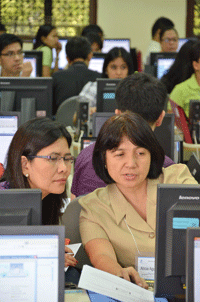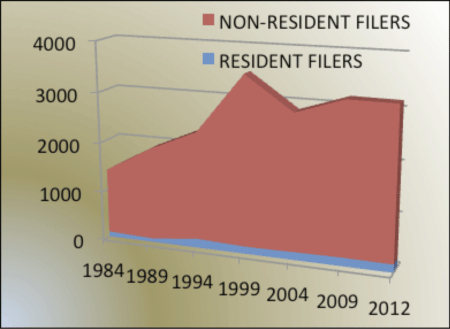
Explotar la innovación: el modelo filipino
By Andrew Michael Ong, former Deputy Director General for policy, international relations and legal matters, Intellectual Property Office of the Philippines

As one of the fastest growing economies in the world, with a growth rate in 2012 of 6.6 percent, there is renewed optimism that the Philippines will finally shed its image as the "sick man of Asia". With robust domestic consumption supporting the momentum for growth and reforms and anti-corruption measures driving improvements in the manufacturing and services sector, the time is ripe for the country to flex its economic muscle. For this to happen, policy-makers need to invest in developing a legal framework, institutions and systems to support innovation and technological development; and businesses need to move from being technology consumers to becoming technology creators by leveraging their research and development (R&D) capabilities to produce high-quality, innovative, value-added products and services.
Maximizing the benefits of patent information
Strategic, development-oriented use of the patent system has a key role to play in supporting innovation and economic growth. Not only do patents act as incentives for continued investment in technological R&D by recognizing and rewarding inventors, they also act as a vehicle to disseminate technological knowledge. All those applying for patent protection are required to explain how their technology works. This so-called "disclosure requirement " makes patents a rich source of technological information.
In addition, patents also transform useful knowledge into tradable property rights, serving as a basis, for example, for establishing technology licensing agreements to facilitate technology transactions among multiple partners and minimize risks of misappropriation or infringement. Many countries use technology licenses to gain access to know-how that exists beyond their borders to enhance industrial and manufacturing capacity at home. There is no reason, in theory at least, why the Philippines cannot leverage the patent system in the same way.
Improving IP awareness: a priority
In practice, however, Philippine businesses demonstrate little understanding of how strategic use of patents can drive innovation and secure a competitive advantage. Low levels of intellectual property (IP) awareness, even among technology professionals and business executives, are reflected in national patent filing statistics. Since the enactment of the Intellectual Property Code of the Philippines (Republic Act No. 8293) in 1984, a consistently low number of patent applications have been filed by residents, accounting for only between 3 and 5 percent of the total number of annual patent filings (see Figure 1). There is clearly huge untapped potential for industry to use patents to strengthen and leverage their R&D activities and create a favorable climate for innovation.
In a move to boost use of the patent system within the Philippine business community and to improve awareness of the strategic value of patents, the Intellectual Property Office of the Philippines (IPOPHL - the government agency responsible for promoting the use of IP for national economic development) refocused its activities. Since 2010, the need to explain the benefits of IP and how it can be used to help achieve the country's development goals has become its foremost priority.
IPOPHL's new vision is capturing the imagination of the national IP community and is also attracting interest in new circles, among groups that had never previously considered IP to be relevant to them. The challenge now is to provide the know-how and the tools these new stakeholders need to use the IP system for their purposes. Developing the knowledge and skills required to research and use patent information seemed an ideal starting point in enabling new users to add value to and leverage their work.

Digital technologies: opening doors to patent information
In the past, searching patent information was akin to finding the proverbial needle in a haystack - time-consuming, impractical and costly. Improved inter-operability of computer platforms and ease of uploading and transmitting digitized information over the Internet, however, are improving information flows, including in the area of patents. These developments plus the sophisticated and powerful database tools and search engines available today make it much easier for researchers, inventors and entrepreneurs to mine the technological information contained in patent documents. This information is a valuable source of business and market intelligence and is being used increasingly to inform and educate stakeholders across organizations and beyond national borders. For example, it provides the raw material for the generation of technology "landscapes" that map the relative density of research in specific areas of technology, offering useful insights that can influence research and investment decisions. In sum, digital technologies have made it possible to tap into the world's accumulated store of patent documents and the wealth of scientific and technological information they contain.
Catalyzing IP creation
Recognizing the multiple benefits deriving from accessing and searching patent information, IPOPHL, set up its Innovation & Technology Support Offices (ITSO) Project. The project was launched in 2010, in tandem with WIPO's TISC initiative to establish Technology Innovation Service Centers (TISCs) in IP offices of member states to support the wider and more active use of patent information by a broader range of interested communities.
The aim was to embed patent information service centers in universities across the country to catalyze the creation of IP by pushing the scientific and technological information found in patent databases to local industries and by helping researchers to use patent information in their work. Universities and colleges are logical homes for ITSOs because they offer a deep pool of knowledgeable professionals and are located throughout the country.
Under the project, each ITSO provides affordable patent information services on demand to the local business community and helps to foster university-industry collaborations in support of innovation. In some instances, ITSOs also offer short courses on IP for faculty members and assist in designing IP course material for university programs. In the absence of a technology transfer office within a university they can also offer support in patent drafting, patent prosecution and the commercialization of technology.
Challenges
Getting universities to buy in to the idea and securing their long-term financial commitment, however, proved difficult. Recruiting faculty members willing to be trained to work in an ITSO was also a challenge. Like their industry counterparts, many faculty members were unaware of the relevance of patent information to them or of the potential benefits of patenting their research. Welded to a mentality of "publish or perish ", many failed to even consider securing a patent on their research before publishing it. Changing these deep-rooted perceptions was a daunting task.
Franchising: a path to financial viability
After almost a year of roadshows engaging with the academic community to highlight the advantages of the initiative, a first batch of 29 institutions signed an initial two-year agreement to set up and operate an ITSO on their respective campuses. In so doing, they also committed to signing a franchise agreement with IPOPHL to operate their ITSO as a financially independent entity that formed part of a country-wide network of franchisees.
In the face of chronic resource constraints, IPOPHL considered that a franchising model was the only realistic way to secure the long-term viability of ITSOs and to safeguard their key role in creating the necessary conditions for innovation. Under the model, after a two-year period during which they receive government support, ITSOs are expected to become financially independent. Management falls to the host institution and revenues are derived from their services to industry. Each ITSO, however, operates under a franchising system. This makes it possible to aggregate resources, ensure high standards of quality, and apply uniform procedures with the backing of a central authority. As the franchisor, IPOPHL establishes the regulations and guidelines governing ITSO operations, and provides technical support, including negotiating preferential terms for the offices to use proprietary patent databases.
At the forum on Access to Technology for Innovation organized by IPOPHL in March 2012, WIPO Director General Francis Gurry noted that "the patent system is responsible for having put together the most comprehensive, the most systematic and most accessible record of humanity's technology. " IPOPHL's ITSO program offers businesses and researchers in the Philippines the key to navigating this wealth of information to advance scientific and technological progress in support of the country's long-term economic development goals. So far, some 50 ITSOs have opened their doors for operation and many more universities are eager to join the program.
While it is too early to gauge the success of IPOPHL's franchise model, the ITSO initiative has already transformed the attitude of academics towards patents. Within university settings, patent information is now widely recognized as a valuable source of technical information and researchers readily explore the feasibility of patenting their work. Hopefully, the benefits of this shift in attitude will soon have a tangible and positive impact on the country's industrial landscape and business prospects.
El propósito de OMPI Revista es fomentar los conocimientos del público respecto de la propiedad intelectual y la labor que realiza la OMPI, y no constituye un documento oficial de la Organización. Las denominaciones empleadas en esta publicación y la forma en que aparecen presentados los datos que contiene no entrañan, de parte de la OMPI, juicio alguno sobre la condición jurídica de ninguno de los países, territorios o zonas citados o de sus autoridades, ni respecto de la delimitación de sus fronteras o límites. La presente publicación no refleja el punto de vista de los Estados miembros ni el de la Secretaría de la OMPI. Cualquier mención de empresas o productos concretos no implica en ningún caso que la OMPI los apruebe o recomiende con respecto a otros de naturaleza similar que no se mencionen.